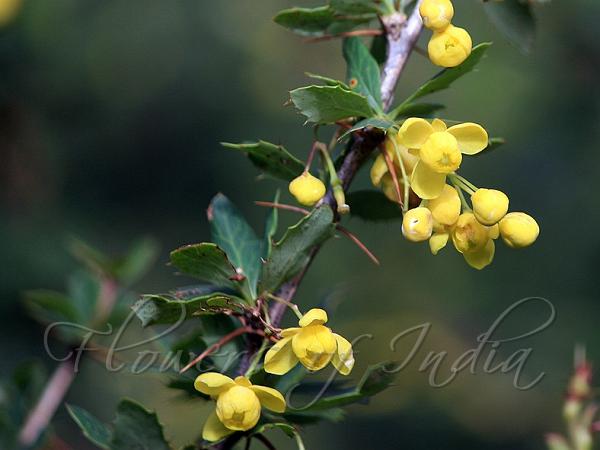|
| Indian Barberry |
|

|

| File size | 122430 |
| Original date | 5/30/23 9:12 AM |
| Resolution | 5184 x 3456 |
| Flash | Flash did not fire, auto |
| Focal length | 146.0mm |
| Exposure time | 1/250s |
| Aperture | 5.6 |
| Focus Distance | |
| Metering Mode | Multi-segment |
| Camera make | Canon |
| Camera model | Canon EOS 700D |
| Sensor type |
|
|
|
|
Photo: |
Botanical name: Berberis aristata Family: Berberidaceae (Barberry family)
Synonyms: Berberis chitria D.Don, Berberis coccinea, Berberis macrophylla
Synonyms: Berberis chitria D.Don, Berberis coccinea, Berberis macrophylla
Indian Barberry is
a shrub up to 5 m. Stems and branches are grooved or angled, hairless or finely
velvet-hairy, reddish brown. Leaves are slightly leathery, leaf-stalk
indistinct. Blade obovate to
narrowly elliptic, 2-6 x 0.5-1.5 cm, base wedge-shaped, tip pointed or
blunt, with a short sharp point, margin entire or with 2-10 spinulose
teeth on each side, dark green above, paler beneath, venation distinct
and slightly raised both sides. Flowers are borne in 4-6 cm long, stalked
panicle like racemes of 10-20 flowers. Bracts are ovate, reddish brown,
2-2.5 mm long. Flowers are yellow, about 1 cm in diameter. Flower-cluster-stalk
0.5-2 cm, hairless. Flower-stalk 0.5-1 cm, slightly glaucous. Sepals are
in 3 whorls, outer sepals ovate, 2-3 x 1-2 mm; median sepals elliptic
or elliptic obovate, 3-5 x 1.5-3 mm; inner sepals obovate, 6-8.5 3 3-5
mm. Petals are obovate, 5-8 x 3-5 mm, base wedge-shaped, tip blunt. Stamens
are 4-5.5 mm long, pistil 5-6 mm long; ovules 3-4. Berries are greenish
purple becoming dark purple to black on ripening, oblong-ovoid, sometimes
asymmetric, 8-10 mm long, slightly glaucous; style thick, 1-2.5 mm long.
Indian Barberry is found in Himalaya to S. Tibet and Central India,
at altitudes of 1300–3400 m. Flowering: April-June.
Medicinal uses: Tree Turmeric is a revered
herb in Ayurvedic medicine. It is claimed to possess antibacterial,
anti-inflammatory, antipyretic and antiseptic properties, the herb is
used as a cholagogue, stomachic, laxative and diaphoretic.
Tree Turmeric is a revered
herb in Ayurvedic medicine. It is claimed to possess antibacterial,
anti-inflammatory, antipyretic and antiseptic properties, the herb is
used as a cholagogue, stomachic, laxative and diaphoretic.
Medicinal uses:
 Tree Turmeric is a revered
herb in Ayurvedic medicine. It is claimed to possess antibacterial,
anti-inflammatory, antipyretic and antiseptic properties, the herb is
used as a cholagogue, stomachic, laxative and diaphoretic.
Tree Turmeric is a revered
herb in Ayurvedic medicine. It is claimed to possess antibacterial,
anti-inflammatory, antipyretic and antiseptic properties, the herb is
used as a cholagogue, stomachic, laxative and diaphoretic. | Identification credit: Prashant Awale, G.S.Goraya, Narain Singh Chauhan, Saroj Kasaju | Photographed in Chopta, Uttarakhand & the Great Hinalayan National Park, HImachal Pradesh. |
• Is this flower misidentified? If yes,